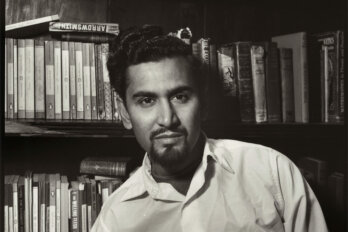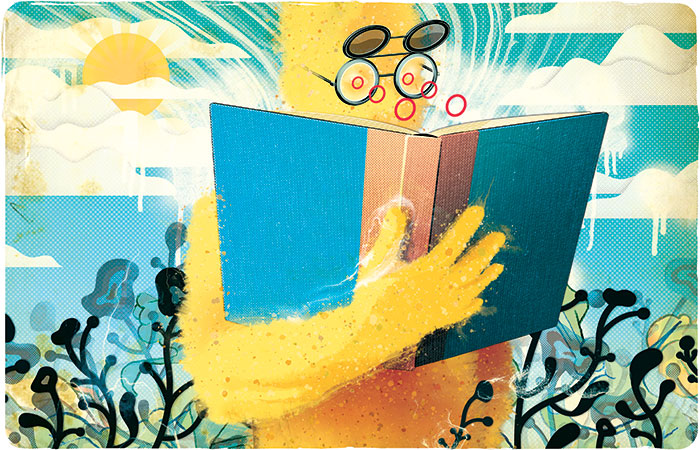
Thieves of Bay Street by Bruce Livesay
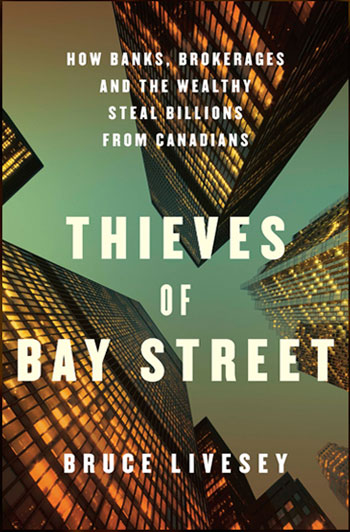 Random House Canada
Random House CanadaWhen three Mafiosi arrive midway through Thieves of Bay Street—to “[open] up like a crepe” a hedge fund executive whom they suspect of picking Rizzuto family pockets—it’s a relief to know there are still villains who limit themselves to old-fashioned violence. A brass-knuckled beating seems refreshing compared to the glut of life-crushing frauds, lies, and swindles crammed into this exposé of Canada’s $6.3-trillion financial sector.
The white-collar crimes are vast and awful, their perpetrators bold and callous. A young, thriving trader (Livesey calls him “the Justin Bieber of Bay Street”) practises “death spiral” financing, driving down the value of public stocks for his own profit. Investment bankers, realizing the worthlessness of a security called asset-backed commercial paper, keep selling it like “a tin of tainted tuna,” until the inevitable collapse separates their clients (which include governments, universities, pension plans, and scores of elderly retail investors) from a combined $32 billion. Conrad Black brutalizes his own newsrooms, bleeds his own balance sheets, but cannot be made to feel the slightest empathy for his prey.
Listeners of NPR’s Planet Money podcast, which has a knack for telling complicated financial stories in plain, vivid English, will note the same talent in Livesey, a veteran investigative journalist and CBC News producer. A dogged reporter, he travels far beyond downtown Toronto to reconstruct the downfalls of Nortel, Stelco, and Black’s Hollinger International, among others. He puts CIBC deeply in bed with Enron and Global Crossing (two of the largest bankruptcies in American history), and shows how it and other Canadian banks lost nearly $12 billion to the sub-prime mortgage meltdown that rocked US markets between 2007 and 2009. Read on, and the Big Five’s “long track record of reckless risk-taking and corporate malfeasance” bursts their puffed-up reputation for stability. Regulators, the last to face the author’s scrutiny, are revealed as toothless, negligent, and conflicted; a special RCMP unit dedicated to financial crimes is expensive and ineffectual. In Ottawa, the author finds insufficient political will to change these realities.
According to an acclaimed expert on market regulation, among Livesey’s dozens of interviewed sources, “Canada is a first-world country with second-world capital markets and third-world enforcement.” And on Bay Street, the centre of it all, we have a four-alarm fire left to burn as it pleases.
—Matthew McKinnon
[breakline]Stray Love by Kyo Maclear
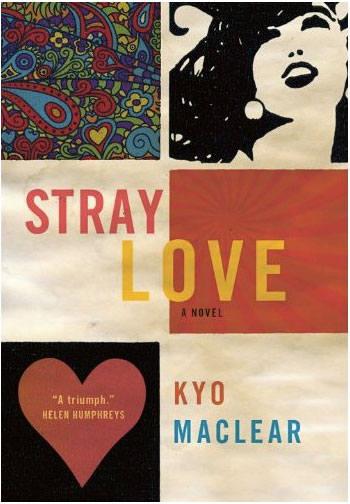 HarperCollins Canada
HarperCollins CanadaMarcel is thoughtful, childless, and approaching fifty when he is charged with the dubious task of caring for a friend’s young daughter. The child is petulant and full of questions, and the unfamiliar experience of being her guardian propels Marcel into a deep recollection of his own childhood, a past fraught with uncertainty and loss. He is on a fruitless, insular search, haunted by a mother he never knew; and the scars of instability, in both the small dramas of familial life and the revolutionary impulses of an era.
Born of adultery in London, UK, Marcel is told at a young age that his father is dead and his mother could not care for him. Struggling with ambiguous parentage and ethnicity, he develops under the care of his surrogate father, Oliver, who despite all his love seems incapable of connection. The intelligent and introverted child matures through the tumultuous, revolutionary ’60s. He suffers through racism and displacement, shifting homes, schools, caregivers, and eventually countries. He watches the adults in his life falter repeatedly in their aim for fulfillment, abusing themselves, their health, and each other. Yet throughout, and perhaps unbelievably, Marcel maintains a drive to succeed and a stability of character.
Maclear’s complex, sweeping narrative travels loaded political terrain, lush in its descriptions and unencumbered by overwrought detail. But despite its artistry, Stray Love never propels into flight. Instead it plods along to a comfortable hum. All of the marks of quality fiction are present, but absent a sharp hook or a fierce punch it fails to be breathtaking, or to break through.
The recovery is the story’s securely constructed yet simple architecture, ambitiously chronicling a lifetime of longing. Marcel’s voice is sympathetic and self-aware, impossible not to appreciate. The novel has an effortless grace, clean and sparse, that allows Maclear’s grander themes—of failing to fit in and an evolving search for identity—to shine through.
—Stacey May Fowles
[breakline]Indian Horse by Richard Wagamese
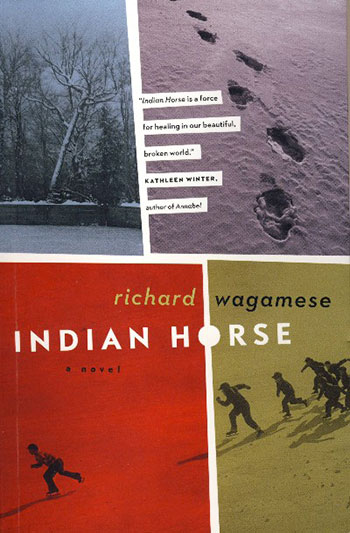 Douglas & McIntyre
Douglas & McIntyreWritten as the fictional memoir of Saul Indian Horse, this new novel is part vision quest, part sports narrative, and part reconciliation story. Growing up in the bush of Northern Ontario during the ’50s and ’60s, Saul comes from a long line of Anishinabeg seers. (In the late nineteenth century, his great-grandfather tapped into the “gift of the original teachers” and introduced horses to the community.) As a child, he senses that he has the visionary gift, a skill his maternal grandmother attempts to nurture. Meanwhile, his parents struggle to reconcile traditional ways with the Catholic world view foisted upon them at residential school. When they abandon him and his grandmother dies, seven-year-old Saul finds himself at St. Jerome’s, a place more like a prison than a school.
Shortly after arriving at the irreverently nicknamed St. Germ’s, he applies his gift to hockey. Able to anticipate the puck’s movement, he excels at the game despite his slight build and eventually earns a spot on an all-Native team in Manitouwadge, Ontario (along with his freedom from the horrors of residential school). The Toronto Marlies soon come calling. But to his white teammates, fans, and opponents, Saul is never simply a good player: “When I hit someone, it wasn’t just a bodycheck; I was counting coup. When I made a dash down the ice and brought the crowd to their feet, I was on a raid. If I inadvertently high-sticked someone during a tussle in the corner, I was taking scalps.” Overwhelmed by overt racism and murky memories of his first hockey coach, he trades the game he loves for the drunken life of a drifter.
The hockey chapters are compelling; they evoke Sherman Alexie’s fiction that examines contemporary life on American Indian reservations through the lens of basketball. But it is as a story of reconciliation that this novel reveals Wagamese’s masterful subtlety. Circles and hoops are common motifs in Ojibway literature, and they abound here—the puck being just one of them. In the end, Saul, now sober, rejects the circle of AA group meetings and revisits the abandoned St. Germ’s. There he finally sees the jarring imperfections of his childhood rink: it is smaller than he remembers, and the corners are more angular than round. In a single image, Wagamese complicates in blinding ways the entire narrative; in a single page, Indian Horse deepens from an enjoyable read to a gripping critique of Canada.
—Kyle Carsten Wyatt
[breakline]Omens in the Year of the Ox by Steven Price
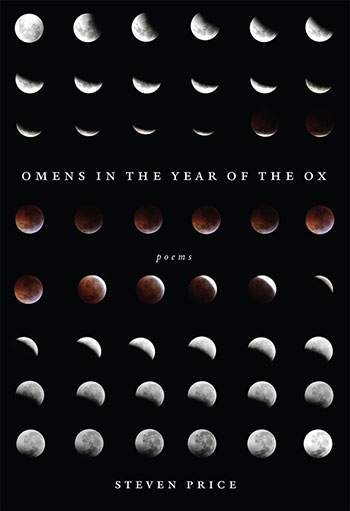 Brick Books
Brick BooksIn the nineteenth century, the English poet and philologist William Barnes attempted to cleanse the English language by purging its Latinate terms and replacing them with his own Anglo-Saxon equivalents; he suggested eschewing “laxative” for “loosensome,” for instance. Barnes was a major influence on Gerard Manley Hopkins, the Victorian poet and patron saint of Anglo-Saxon linguistic purism. Hopkins (who in “The Windhover” wrote, without embarrassment, “I caught this morning morning’s minion, king- / dom of daylight’s dauphin, dapple-dawn-drawn Falcon”) was once asked by a fellow poet, “How is the world’s bright shift held / in such a cluttered line?”
In his sophomore collection, Omens in the Year of the Ox, Price, a key practitioner of pine-beetling Canadian maximalism, takes up where Barnes and Hopkins left off. He quotes the question above in “The Crossing,” the book’s first poem, and readers who have grown suspicious of Canadian poetry’s reduction to internal rhyme and indulgent diction may find themselves thinking Hopkins’ buddy probably had a point.
Where a one-dollar word would do, Price offers up Barnesian five-notes: “bladderwrack,” “dreep,” “gleeched,” “gleetslicked,” “screeled,” “streaping.” These aren’t the mots justes, just the mots juiciest. This technique muscularizes the line but, as with a bodybuilder, renders it inflexible. Or, as Price writes, indeed rather beautifully, ropes “his muscles in knots / of their own cording.”
Omens in the Year of the Ox is a highfalutin mix of melodrama and myth, where mean swans and dead raccoons and guys who knife women on trains for no reason share space with more sonorous and pre-masticated Western tropes: Odysseus, Orpheus, the Magi. The jacket copy explains that “these are dark poems.” That’s an understatement: this is one of the bleakest books in recent memory. I tried to tally how many times Price uses the words “dark” (fifty) and “black” (thirty-five), then gave up in despair. This isn’t thematization; it’s pathology. Worst of all, he regularly employs these already clichéd, nebulous poeticisms as the vehicles for metaphors or similes that gain no purchase, as when “blood-dazed, black ants swarm / like a hive of darkness.”
The Hopkinsizing of Canadian poetry was necessary two decades ago, when a flaccid limpidness dominated our verse. But the revolution has run its course and has turned tyrannical. Price’s generation was right to redirect the country to the nativity of the English language, but surely, twenty years on, we don’t have to relive it all again.
—Michael Lista
[breakline]Magnified World by Grace O’Connell
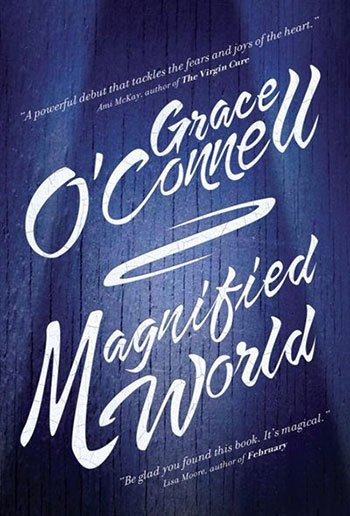 Random House Canada
Random House CanadaThis quiet debut novel follows its twenty-three-year-old narrator, Maggie, as she grapples with the recent suicide of her mother, whose clinical depression belies the holistic optimism of her New Age shop, which sells healing crystals and tarot cards. For Maggie, grief manifests in the form of blackouts—swirling, menacing black holes that leave her convinced that she, like her mother, is losing her mind. Unable to connect with her father, her best friend, or her boyfriend, she seeks comfort in Gil, a customer who may or may not be a chimera in the Drop Dead Fred tradition, and who claims to have valuable intelligence about her mother’s unknown past in the American South.
While O’Connell’s themes—memory, grief, alienation—are ambitious, her execution is mechanical. Maggie’s mother drowned after filling her overcoat pockets with rocks and walking into Toronto’s Don River, an obvious wink to Virginia Woolf’s suicide by the same method. The allusion could have worked if it had been applied more thoughtfully; instead, it shrinks away with no payoff. Neither Woolf’s work nor her life figures into the plot, making the pointed reference feel unnecessarily showy. Maggie’s self-awareness and insight seem artificially prescient, while the interludes of flashback peppered throughout are imbued with the right amount of textbook symbolism but feel arbitrary. Even the blackouts are a McGuffin, propelling the plot forward yet lacking a satisfying resolution.
O’Connell’s plot and structure don’t quite hold up, but she’s a beautiful writer. Line by line, her prose is sensate and evocative, toying with words and images and reframing them in wonderfully counterintuitive, surprising ways: bruises “bloom faintly, pink to brown to yellow,” and Maggie describes herself “mentally checking the city like a tongue running over the empty socket of a tooth.” Unfortunately, as a whole, her book is too formulaic to have the same effect as her prose.
—Emily Landau
[breakline]Amen: What Prayer Can Mean in a World Beyond Belief by Gretta Vosper
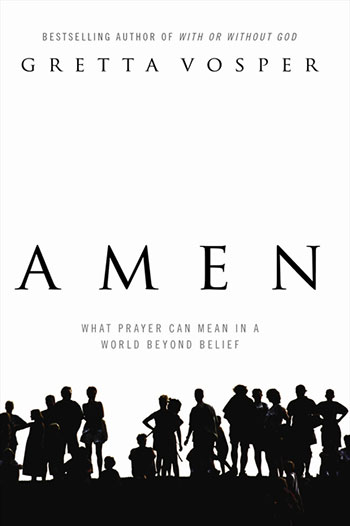 HarperCollins Canada
HarperCollins CanadaWhether proclaiming “Allahu akbar,” singing “Shema Yisrael,” or reciting “Our Father, who art in heaven,” prayer is central to the three major monotheistic religions, and to many others besides. According to the nineteenth-century German philosopher and theologian Ludwig Feuerbach, “The ultimate essence of religion is revealed by the simplest act of religion—prayer.” It’s easy to understand why: prayer is the moment when the private individual addresses the divine.
In her new book, Vosper examines the history and nature of prayer and explores whether it can be rescued from the delusions and political ignominies she associates with mainline theism: the patriarchism and homophobia, the relegation of people from other traditions to the realm of the damned.
Vosper, the minister at West Hill United Church in Toronto, divides the basic modes of prayer into adoration, confession, thanksgiving, and supplication. She assiduously demonstrates how, traditionally conceived, they all rely on the expectation that God will “intervene, act on our behalf as the supernatural agent of goodness.” But that need not be the case. “The opening acts of adoration and praise,” she writes, drawing on her experience conducting services for the Church, “are completely without any need for action on the part of the deity.” Adoration, and all the other types of prayer, she suggests, can be understood as addressing, rather than a supernatural being, “the values we choose to hold as sacred in our community and in our lives.” And for Vosper, justice and compassion, a willingness to take responsibility for the effect of one’s actions on others and to act on it, are central to what those values should be. “We have no prayer that can keep us safe,” she writes. “We have no prayer that can intervene in the laws of the universe and keep away illness, evil, calamity… We have only ever had ourselves.”
It is hard to fault her for wanting us to focus on justice and compassionate living, and for asking us to give up delusions that are often destructive; she is especially concerned with traditional religion’s damaging effect on the psychological development of children. Yet the notion of prayer salvaged in Amen constitutes little more than an emotionally charged form of reflection. The tradition of prayer at its highest and most sublime, from St. Augustine and St. John of the Cross to Thomas Merton, has always been the moment where the agonized soul stands naked before the divine. It is this overwhelming encounter with the transcendent that is lost in Vosper’s world beyond belief. That may be for the best, but she should acknowledge that something powerful has been given up. The moral and the sacred are simply not the same thing.
—Daniel Baird
The Juliet Stories by Carrie Snyder
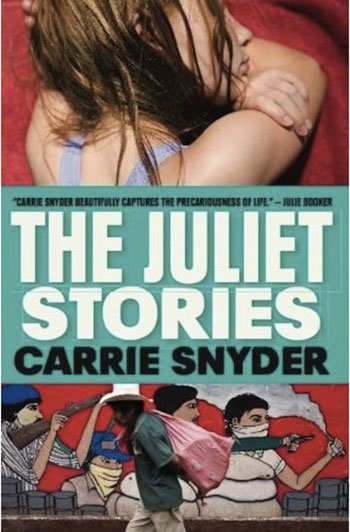 House of Anansi
House of AnansiWriting a novel as a series of short stories is a challenging project. By its very nature, it results in a disjointed narrative, necessitating an artful hand that can interlock the pieces into a viable whole. Reading such a story also proves challenging; the central hook is not a tight, propelling plot, but rather the deftness of the writer’s craft.
Snyder’s new book is the rare successful execution, a stream of sensual imagery that grows more sophisticated with each page. We begin with Juliet at age ten, accompanying her family to Nicaragua during the post-revolutionary war. As she faces the perils of growing up, the broader conflicts of the period become irrelevant: “If she is bold, if she exudes a vague hysteria,” Snyder writes, “it is because she has no awareness of being afraid.”
The increasing complexity is a neat trick for a coming-of-age tale: the collection’s slow language shift mirrors the development of its title character. In one scene, Juliet reads Alice Munro’s Lives of Girls and Women, a wink from Snyder regarding her tactic; “it frightens her in a way she cannot explain… a terrible feeling swells in her: that as she grows older she is tumbling forward and down, faster and faster, out of control.”
Juliet’s childhood is rich with depictions of freedom, but also fraught with the incomprehensible discovery of tragedy. When her brother becomes ill, cancer is described as “a disruption, a word that can be spoken only in a whisper,” while he “shrugs off” the humiliation of his given nickname, cancerboy. As it unfolds, the collection takes stunning detours, a benefit of the fragmented form. “Dear Ronald Reagan,” for example, steps out of trajectory to encapsulate the subtler elements of Juliet’s character through the letters she writes.
Ultimately, despite its lushness—or perhaps because of it—this book demands much from readers, and may frustrate those who expect an A to B progression of drama. For those who endure, the textured imagery, heavy with meaning, provides its own reward. The Juliet Stories highlights the lessons we learn in youth and with age, and the conflict between the freedom we value and the security we desperately need.
—Stacey May Fowles
This appeared in the June 2012 issue.


